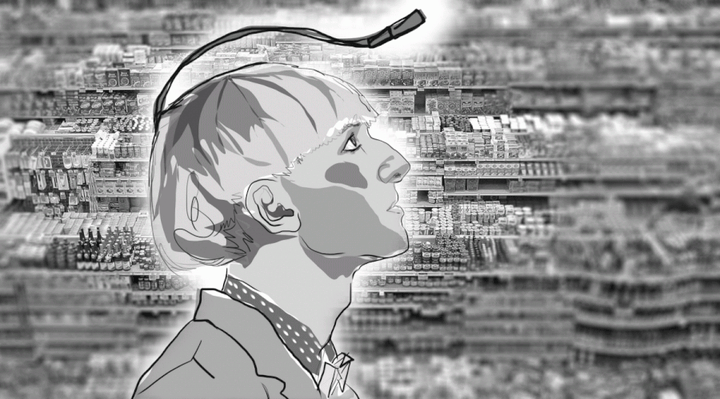
Bodies are imperfect. Every combination of flesh, nerves, bones and blood has its particularities and limitations, some of which restrict the experience of its owner more severely than others.
For issues that threaten our safety and survival, technology offers a helping hand. Glasses improve vision. Crutches, wheelchairs and prosthetics help with movement. For those with abnormal heart rhythms, there are pacemakers.
But what about the less dire limitations, for example, those that affect your aesthetic perception? How would your life be different if you couldn't see color, if the range of your vision was limited to various degrees of black and white?
Getting dressed, chopping vegetables, flipping through TV channels and magazine pages -- many banal yet stimulating sensual experiences would be drained of their vigor, swapped out for ashen simulacrums. Routine activities like obeying traffic signals and road signs would become strenuous, potentially dangerous. Colorblindness is often regarded more as a quirky personality trait than a serious affliction, though for some, the ascetic diet for the eyes saps daily life of its juice.
Facing such a condition, would you turn to technology's helping hand? Would you ever, say, consider becoming a cyborg? It sounds radical at first, although, in actuality, most of us are already micro-modifying our bodies fairly frequently, every day, from the moment we wake up. A cup of coffee, perhaps an Advil, moisturizer, makeup, vitamins, contacts -- all before leaving the house.
Could you be tempted by the opportunity to enhance your body by inextricably binding your flesh with technology? Perhaps the better question is, have you done so already?

Harder, better, faster, stronger
Oren Etzioni, Executive Director of the Allen Institute for Artificial Intelligence, defined a cyborg as "part person, part machine," in an email to The Huffington Post.
In her feminist text "The Cyborg Manifesto," Donna Haraway takes a more theoretical approach. "A cyborg is a cybernetic organism, a hybrid of machine and organism, a creature of social reality as well as a creature of fiction."
Then there's artist Neil Harbisson. He explained to The Huffington Post that, from his perspective, the term cyborg explores "how technology could be used as a sense and not as a tool." He should know. Harbisson, after having an antenna implanted into his skull, is the world's first legally-recognized cyborg.
Harbisson's body modification is a curved antenna that shoots up from the back of his head and rests dangling between his eyes like a comic book superhero equipped with insect feelers. With a sharp-edged bowl cut and a penchant for neon-colored suits, Harbisson's image lands somewhere between a 1960s boy band frontman and an alien avatar, almost but not quite blending in.
By profession he is an artist, but it's clear from a single glimpse that Harbisson is also a work of art. Not to mention, a radical scientific achievement.
"Becoming a cyborg is, in a way, modifying your body as if it was your sculpture," Harbisson said. "I believe that cyborgism is the art of creating your own senses, your own body parts, and then expressing yourself. When that happens, you become the artwork."
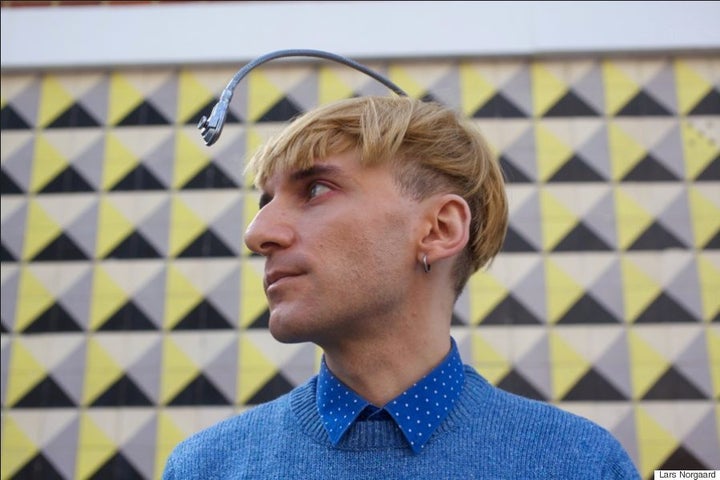
So many shades of gray
Harbisson's journey toward becoming a cyborg began, essentially, at birth. He was born colorblind; specifically, Harbisson experienced a rare form called achromatopsia, which allowed him to see the world only in shades of gray. As far as colorblindness goes, he possessed a severe and rare form, affecting one in every 33,000 people.
These days, however, Harbisson holds an even more singular condition, sonochromatopsia. The odds of experiencing it are about one in seven billion. Derived from "sono" (Latin for sound), "chromat" (Greek for color) and "opsia" (Greek for visual condition), the term, created especially for Harbisson, implies the possession of an extra sense -- the ability to hear color.
Harbisson's sonochromatopsia is distinct from synaesthesia, a neurological phenomenon in which an experience in one sensory pathway sparks an automatic and unconscious experience in a second sensory pathway. So a person with synaesthesia could, for example, see music or taste color.
While some synaesthetes can indeed hear color, Harbisson is not hearing with his ears; rather, he is experiencing color through an audible vibration transmitted via antenna to his skull.
"I don't need to open my eyes. I can hear colors with my eyes shut," Harbisson said. "The way I hear color is not the way I hear sound. It's a different sense."
Harbisson acquired this inhuman ability thanks to what he calls an eyeborg, the coiling affixed to his skull. With the help of said eyeborg, Harbisson's brain automatically distinguishes light's hue and converts it to an audible frequency, like a music note that skips the ears and goes straight to the brain. "For me the sense of color is an independent sense, it doesn't relate to sight or to hearing."

Born in Belfast, Ireland, and raised in Catalonia, Spain, Harbisson, now 32, felt from a young age that he was different. Many a stoned college student has tripped out pondering the possibility that "my green may not be the same as your green, and neither of us would ever know it." For Harbisson, this wasn't far from the truth. "I noticed that other children in class could identify color easily and I couldn't. I knew there was an issue with color, but it wasn't until I was 11 that I realized I wasn't confusing colors, I couldn't see them at all."
How much would digesting the world in grayscale affect your daily life? It's impossible to say, just as it's impossible for a person who is colorblind to visualize a tangerine-tinted sunset. Travis Korte, a data scientist who experiences deuteranomaly colorblindess, a less intense variation that affects about six percent of the population, expressed a similar sentiment. "If I woke up one morning not colorblind, would my mind be blown? Or would I be disappointed that I wasn't missing out so much in the first place and had no idea."
He added: "It is a little bit alluring, the idea of doing some modification to know what I've been missing."
In part because of his colorblindness, Harbisson wasn't all too interested in visual arts as a kid. He did, however, play piano and eventually studied experimental music composition at Dartington College of Arts in Devon, England. It was there that Harbisson attended a lecture by cybernetics expert Adam Montandon, who introduced him to the transdisciplinary approach of exploring regulatory systems. "That's where I discovered the potentials of cybernetics," Harbisson said.
Merriam Webster defines cybernetics as "the science of communication and control theory that is concerned especially with the comparative study of automatic control systems." If the definition sounds unnecessarily cumbersome, it's because the term itself is so tricky to pin down.
At what point does your body become so inextricably linked with its technological auxiliaries that your very categorization as a human being no longer holds? "Is a person wearing Google glass a cyborg?" Etzioni added in his email. "How about an Apple Watch? How about a brain implant?"
Visions of futuristic beings donning metal helmets, sprouting cables and cords spring to mind. But then again, look around your local coffee shop and peruse its inhabitants, with ears exuding plastic-coated wires that link up skeleton and screen. Maybe our imaginary, sci-fi inflected cyborg stereotypes need a 2015 reality check.
For Donna Haraway, cyborgs aren't only a thing of the future. "By the late twentieth century, our time, a mythic time, we are all chimeras, theorized and fabricated hybrids of machine and organism; in short, we are cyborgs."
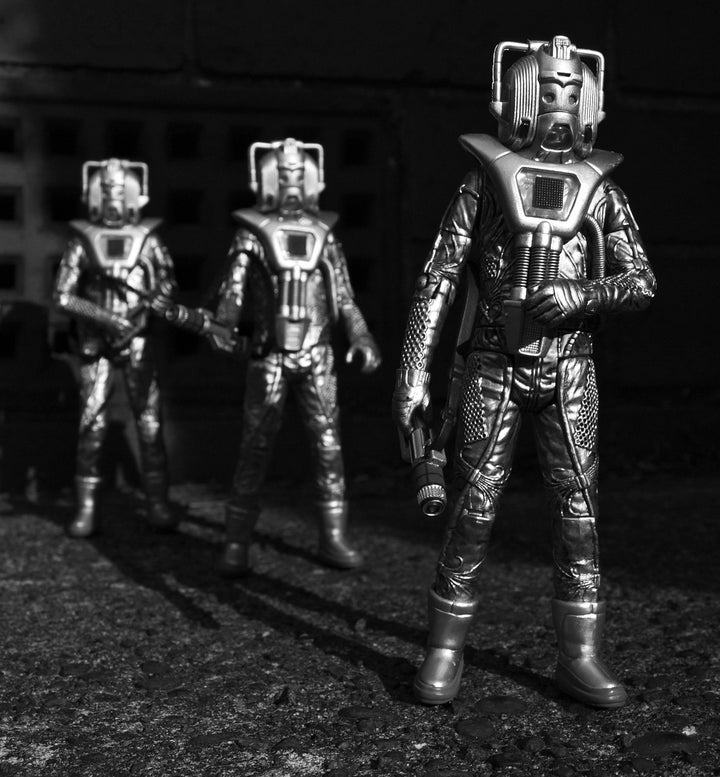
Taste the rainbow
As a student, Harbisson ended up collaborating with Montandon on the first incarnation of the eyeborg, serving as Harbisson's final college project. At this point, the apparatus was an antenna with a webcam at the end, attached to a computer and a pair of headphones. The webcam translated each color into a sound wave that traveled to Harbisson via the headphones. He refined the operation over time, reducing the size of the computer and strapping it under his clothes.
Now, the computer has been shrunk to the size of a chip and the antenna is embedded directly into Harbisson's skull.
It wasn't easy to find a doctor to perform the operation, the first of its kind. The doctor who eventually agreed to perform the surgery asked to remain confidential.
After months, the implanted antenna finally merged with Harbisson's occipital bone, and the mechanism was fully osseointegrated inside his skull. Suddenly, Harbisson could hear the many light frequencies of the color spectrum, including colors invisible to the eye such as infrareds and ultra violets.
"When it was implanted in my head, it became like a body part, and was much more comfortable," Harbisson said. Even so, the adjustment took time. "Hearing color was very overwhelming, because color is everywhere. I had to get used to the fact that everything I looked at had a sound."
It took approximately five weeks to acclimate to the new incessant sense and the headaches that accompanied it. At first, Harbisson consciously worked to memorize the names of the colors he was hearing, eventually matching up a different frequency with each of the 360 shades of the color wheel. After about five months, the system became a perception and the perception became a feeling. "Eventually it just became natural," he said.
And then everything was different, in a way that, for all of us except Harbisson, is difficult to imagine. A world in black-and-white buzzing with frequencies, humming an ambient portrait straight into the brain. Certain places purred at especially appealing rhythms. "It's very attractive to walk along the supermarket," Harbisson explained in his TED Talk. "It's like going to a nightclub, full of different melodies. Especially the aisle with cleaning products!"
Even when his eyes are closed, Harbisson keeps seeing colors, as the hues swirling in his imagination conjure their respective audible equivalents. "When I dream, I hear and perceive colors, but it's created by my imagination, not by software," he explained. "That's when I felt like the cybernetic device had become an extension of my senses."
Although Harbisson is the only person to currently experience sonochromatopsia, any future cyborgs would experience the exact same correlation between color and sound, which works both ways. His enhanced perception allowed Harbisson to divine unlikely connections between the two -- telephone rings are green, Mozart concertos yellow, Amy Winehouse pink. Rothko paintings produce clear notes -- reminiscent of the meditative sounds of a crystal bowl sound bath, while Leonardo Da Vinci's use of chiaroscuro yields what Harbisson likens to a horror film soundtrack.
While the rest of us color coordinate, Harbisson harmonizes.

Transformed by the power of art
On a good day, artists can tap into something vital humming ever so gently in the distance, before it becomes audible to the rest of us. The body and the self, in the past 25 years, have become handy media for the radical multidisciplinary artist, with identities now as malleable as clay -- and, artistically speaking, far less warmed-over.
Although she does not consider herself a cyborg, French artist Orlan was the first to experiment with artistically-inclined physical surgery. For her 1990 piece "The Reincarnation of Saint-Orlan," she surgically modified her body nine times to imitate specific ideals of beauty established throughout Western history by male artists. Her goal was to acquire, for example, Mona Lisa's forehead and Venus' chin, as painted by Botticelli.
"I have been the first artist to use aesthetic surgery in another context -- not to appear younger or better according to the designated pattern," Orlan explained in an earlier interview with The Huffington Post. "I wanted to disrupt the standards of beauty."
Much of Orlan's work explores the masculine pressures that often invade feminine flesh. Yet instead of condemning such compulsions, Orlan invites them in, incorporates them into herself, thereby blurring the initial categories until they no longer hold. "I don't know who are the men and who are the women," she said. "In French I used to say 'je suis un femme et une homme.' That is to say a feminine male and a masculine female. A she man and a he woman. What I am interested in is developing a singularity, which would be my own."
Actress and Olympic athlete Aimee Mullins believes such limitless self-fashioning shouldn't be reserved for creatives alone. "I love the power of the individual to create their body and their identity in a way that makes them happy," she explained to the Huffington Post. "There is more room being made for that than ever before."
Mullins was born without fibula bones and, as a child, was told by doctors she would likely never walk. Her best shot, doctors told her, was to amputate her legs at the shins, hoping she'd learn to move via prosthetics while her peers learned to walk on their legs. She did, and quickly outpaced them all.
Wearing prosthetics, Mullins competed in the Paralympics in 1996 in Atlanta, Georgia, and, before retiring from track and field two years later, set world records in the 100-meter, the 200-meter and the long jump. Aside from her athletic accomplishments, Mullins also revels in the aesthetic and conceptual capabilities of her prosthetic limbs. While many collect shoes, she collects legs, with over 12 pairs to her name. Some resemble cheetah legs and translucent jellyfish tentacles, while one pair, designed by fashion icon Alexander McQueen, features wild, gnarled vines carved into elm wood. Mullins was a muse to the late McQueen, as well as to conceptual artist Matthew Barney, having appeared in his video works "Cremaster Cycle" and "River of Fundament."
Mullins isn't physically bound to her technological ancillaries, though at times she considers them a crucial part of her bodily composition. "Some prosthetics absolutely are a part of my body and I think that if you wear technology, especially in an intimate way, there is, in a way, an energy exchange between materials," she said.
Unlike Harbisson, Mullins dons and removes her body modifications each day and, as such, does not identify as a cyborg -- or a living sculpture, for that matter. "I don't consider my entire self an artwork," she said, "but there is something of it being a performance piece when I go out in optically clear legs that look like glass and are 10 pounds each. To me, it's about inviting the conversation that comes with that. Inviting people to ask me questions, challenge what they thought the space between the body and the ground should look like."
For Harbisson, the separation between body and artifice does not exist. "My life is part of my art, there is no separation," he said. "I see becoming a cyborg as an artistic statement. I see cyborgism as an art movement, the art of creating your own senses, your own body parts, and then expressing yourself. When that happens, you become the artwork."
Beyond the aesthetic experiment that is his own life, Harbisson has also generated an entirely new form of fine art, a technique he refers to as creating "sound portraits," brief moments of pure sound that capture the colorful essence of a human face, as experienced by Harbisson. The ambient chords range from harmonious to dissonant; Nicole Kidman could lull you to sleep while Prince Charles resembles an ominous Trent Reznor soundtrack.
Charles was the first subject of Harbisson's unconventional portraiture. The two met when the Prince came to Harbisson's university in 2005 and asked about the device dangling above his head. "I told him it was an antenna to hear colors," Harbisson said. "I asked him if I could listen to him, to hear the colors of his face. I wrote down the notes and that was the first sound portrait. I didn't really plan it, it just came naturally."
Soon after, Harbisson embarked on the next logical move, transposing sound into color. "When I listened to music I could paint what I heard. I started with very simple melodies and then got more complex. I start in the middle and keep adding layers of color, which are the notes of the piece, until the canvas ends." The resulting images resemble hard-edged electric tapestries, vortexes of vivid colors layered at a dizzying pace. The vertiginous images are portals into Harbisson's mind, DayGlo-colored mazes that emphasize the singularity of Harbisson's sensual experience.
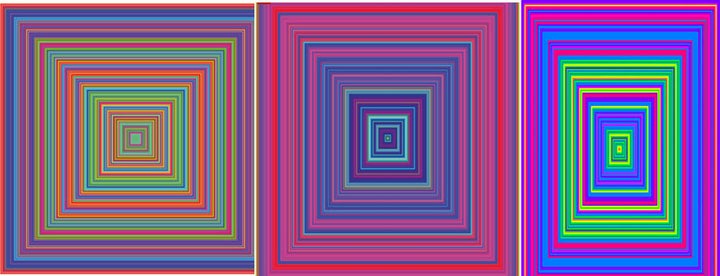
As his electric lattice portraits reveal, Harbisson's mind can function as an artistic laboratory, as visual and aural input triggers the generation of novel material. And if the raw goods streaming in from Harbisson's antenna and imagination were not enough, his skull is Bluetooth-enabled allowing his mind to connect to the Internet and experience any hues out of reach.
"I can receive colors from other parts of the world," he explains. "If someone in Australia wants to send colors to my head they can use their mobile phone and they can send live images of a sunset for example, and I can perceive a sunset from wherever I am. Times like this are when I actually enjoy color the most. It's as if I have an eye somewhere else."
Harbisson's unusual encounters with color, without actually using his eyes, recall the work of artist James Turrell, who famously said light "is not the bearer of revelation -- it is the revelation."
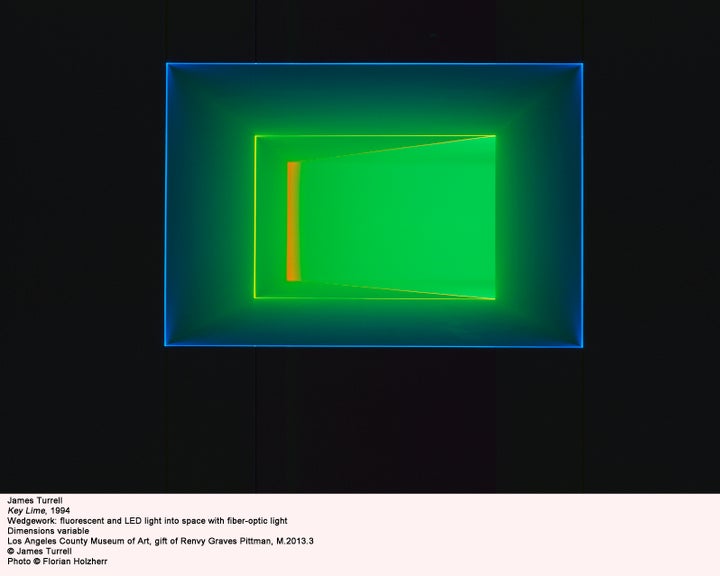
Turrell is known for his immersive, hallucinatory installations in which light becomes not an adjective but an amorphous, all consuming noun. His buzzy "Perceptual Cell" invited one viewer at a time into an enclosed white dome to experience 12 minutes as a vessel of perception. The viewer lies down and absorbs a pulsing stream of pure light and color, revealing that color does not only exist outside of us, in space, but also inside our eyelids, clamoring against our skulls. The uncanny resemblance between Turrell and Harbisson's work hints at this notion that they both know something we don't.
Turrell's other works, large scale LED worlds that leave the viewer mystified and discombobulated, almost resemble three dimensional enactments of Harbisson's colorful translations of sound. "I become a transparent eyeball," Ralph Waldo Emerson wrote in his 1836 essay "Nature." Christopher Knight alludes to the quote in his review of Turrell's LACMA show. It seems, perhaps, an even better fit for Harbisson.
Science and art have the power to transform, to turn metaphor and myth into something tangible, whether via medical procedure or immersive installation. In fact, Turrell insists his Perceptual Cell yields the exact same experience for colorblind participants and non-colorblind participants.
Such confounding overlaps illuminate the close proximity of art and science, two creative fields that make the imagined real. Haraway's extended definition springs to mind: "The cyborg is a condensed image of both imagination and material reality."
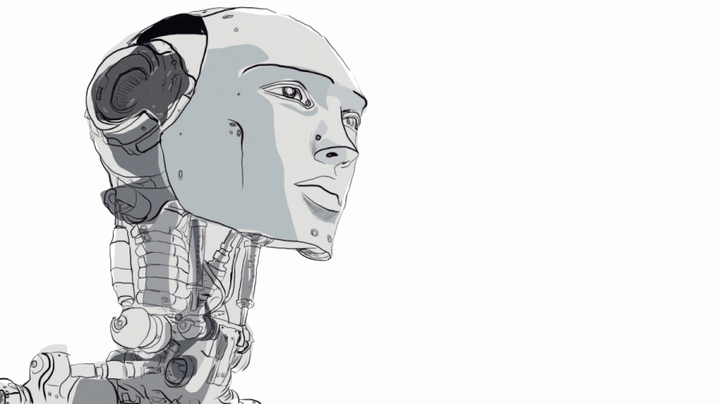
Become who you are
A cyborg is a hybrid between man and machine, reality and fiction. Yet in spirit, at least according to Haraway, the cyborg is a symbol of hybridity in general, of a life beyond binaries, of eternal becoming and perpetual in-between-ness.
When discussing his surgery, Harbisson compared the stigma surrounding cybernetics to that surrounding transgender identity in the 1950s. "Doctors said that [gender confirmation] operations were not necessary, could potentially be dangerous, and they were concerned about what others would think," Harbisson said.
"Now [with cyborgs], it's the same. It's not necessary to extend our senses, it may be dangerous, and what would people think?"
Of course, it's a major professional risk to embark on a surgical procedure without precedent. "Doctors bear the incredible burden of caring for their patients, and so are appropriately conservative at times," Etzioni explained. "When cybernetic technology has proved itself -- this will change, but slowly."
In fact, it's already changing. Harbisson, along with his friend Moon Ribas, founded the Cyborg Foundation in 2010, in part to defend what he's dubbed "cyborg rights." However, as Harbisson expressed clearly, "The main right we are fighting for is the right to have surgery."
Some cyborg transitions are marked by surgery. But, at its core, becoming a cyborg is a matter of self-identification. To make a designation defined by hybridity a "yes or no" question misses the point entirely. Just as one can can identify not only as male or female, but infinite variations outside and in between, one can establish a multitude of relationships between body and its technological faculties.
Comparisons between the transgender and the cyborg communities are certainly limited, but there are some parallels; some individuals in both groups would argue they embody futurist goals of openness, hybridity, potential. They would also say they understand the body we're born with is not the body we're tethered to and that just because something is biological does not mean it is authentic.
"It is also an effort to contribute to socialist-feminist culture and theory in a postmodernist, non-naturalist mode,"Haraway explains in The Cyborg Manifesto, "and in the utopian tradition of imagining a world without gender, which is perhaps a world without genesis, but maybe also a world without end."
In other words, specifically those of Friedrich Nietzsche, both movements allow human beings to become who they are.
"We, however, want to become those we are -- human beings who are new, unique, incomparable, who give themselves laws, who create themselves."
In an ever-evolving technological landscape, how will you construct yourself -- a nose job, a tattoo, an eyeborg? How will you enhance your body -- a workout routine, an eating habit, a prosthetic part? How do you want the world to perceive you and, more importantly, how do you want to perceive the world?
"I think it's best to use cybernetics to extend our senses and perceptions of reality," Harbisson concluded. "The more we can perceive, the better we can understand where we are and who we are. I think it's an essential part of our evolution."
An artist of the most unusual variety, Harbisson is devoted to helping mankind evolve. Classic cyborg behavior.
Also on HuffPost:

